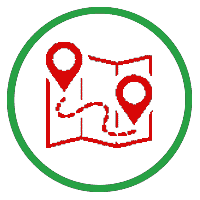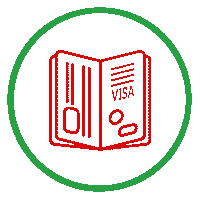Iran Cities
TEHRAN













Tehran Bozorg (Greater Tehran), the capital of the Islamic Republic of Iran, is one of the largest metropolitans of the world, and it is the country’s largest economic center and the base for its large and small modern technological and industrial establishments. Located on the slopes of the mountains and at the foot of the magnificent Mount Damavand, it has been the country’s capital city for over 200 years now. Nearly 14 Million people live in Tehran in contrast to two hundred thousand in 1920.
The first mention of Tehran in an old geographical text is made in the 10th century Massalek-al Mamalek (The Ways of States) by Estakhri. It was just a village before the Safavid era.
By the Mongols’ invasion and the consequent severe devastation the city of Rey received, most of the Rey’s people took refuge to this village.
This was a starting point for growth of Tehran, and gradually this village that was famous for its fine fruits and beautiful gardens, underwent new developments. Shah Tahmasb, one of the Safavid kings, chose Tehran as administrative center for the Safavid dinastry, which resulted in constructing many big governmental buildings, castles and gates.
At the time of the Zand dynasty, it was a small town that was significant from a military point of view. The first of the Qajar kings, Agha Mohammed Khan, named Tehran as the country’s capital in 1789. Nevertheless, the capital’s development started at the time of another Qajar monarch, Fath-Ali Shah. The citadel, which Agha Mohammed Khan had built, was developed to include the new royal buildings.
At the same time, the city’s population was redoubled. With the increasing importance of the city, soon gates, squares and mosques were built and it was at the time of Nassereddin Shah that the city’s master plan was prepared and modern streets were formed. Later, large central squares like Toopkhaneh (now Imam Khomeini) square and several military buildings were constructed. With the decline of the Qajar dynasty, Tehran soon took the shape of a modern city. The construction of large government buildings, new streets, recreation centers, urban service establishments, and academic and scientific centers were started, while most of the old gates and buildings were destroyed and the city’s old architectural fabric replaced by a modern one.
With an altitude of 1200 meters above sea level, Tehran is a city of all four seasons with hot summers, freezing winters, and brief springs and autumns. The highest recorded summer temperature in Tehran has been 42 degrees centigrade while the lowest has been registered at 8 degrees below zero.
Tehran is pleasant, it derives its originality from its dry climate, always cool in the evening, the nearness of the mountains, its numerous parks and gardens where flowers blossom throughout the year, the alleys of trees in the avenues or even smaller streets, the water which runs down from the upper city along deep and wide gutters which look like small rivers during spring.
Dams of Karaj, Latian and Lar supply Tehran’s drinking water and parts of the country’s electrical power. These dam-lakes and river-sides provide also valuable tourism sites for visiting and enjoying walking and viewing beautiful natural sites as well as practicing various kinds of sports, including water sports. There are dozen of small coffee-houses with zinc roofs nestle among the bushes. Mountain streams run among the tables. But everyone does not sit around a table; many of the customers prefer the ancient-style comfort of low divans covered with old carpets. Delicious “kababs” are consumed, and hot teas are served from “Samawar”.
The Alborz range on the north of Tehran, which host the highest peak in the country during winter provides a very suitable climate for ski lovers. In winter, the mountain hotels and ski-clubs at Shemshak, Shahrestanak and Dizine are full several days a week. Some expert skiers consider the snow quality in northern Tehran to be one of the best in the world.
The highest peak in the country, Mount Damavand (5671 Meter), which is an extinct volcano covered in snow for most of the year with its visibility from Tehran has an attractive appeal for adventurers and climbers.
The Golestan (Rose Garden) Palace is one of most visited places in Tehran, which was the Qajars’ royal residence. Its garden is an oasis of coolness and silence in the heart of the city. The main building, architecturally unpretentious, houses a museum with objects from the Qajar period in the overloaded and pompous style of last century. In the Golestan garden, a one-story pavilion to the right and slightly behind the entrance, shelters one of the best organized museums in Tehran. It contains about thirty showcases presenting everything, which makes up the basic originality of Iranian life in the various provinces of the country.
The first mention of Tehran in an old geographical text is made in the 10th century Massalek-al Mamalek (The Ways of States) by Estakhri. It was just a village before the Safavid era.
By the Mongols’ invasion and the consequent severe devastation the city of Rey received, most of the Rey’s people took refuge to this village.
This was a starting point for growth of Tehran, and gradually this village that was famous for its fine fruits and beautiful gardens, underwent new developments. Shah Tahmasb, one of the Safavid kings, chose Tehran as administrative center for the Safavid dinastry, which resulted in constructing many big governmental buildings, castles and gates.
At the time of the Zand dynasty, it was a small town that was significant from a military point of view. The first of the Qajar kings, Agha Mohammed Khan, named Tehran as the country’s capital in 1789. Nevertheless, the capital’s development started at the time of another Qajar monarch, Fath-Ali Shah. The citadel, which Agha Mohammed Khan had built, was developed to include the new royal buildings.
At the same time, the city’s population was redoubled. With the increasing importance of the city, soon gates, squares and mosques were built and it was at the time of Nassereddin Shah that the city’s master plan was prepared and modern streets were formed. Later, large central squares like Toopkhaneh (now Imam Khomeini) square and several military buildings were constructed. With the decline of the Qajar dynasty, Tehran soon took the shape of a modern city. The construction of large government buildings, new streets, recreation centers, urban service establishments, and academic and scientific centers were started, while most of the old gates and buildings were destroyed and the city’s old architectural fabric replaced by a modern one.
With an altitude of 1200 meters above sea level, Tehran is a city of all four seasons with hot summers, freezing winters, and brief springs and autumns. The highest recorded summer temperature in Tehran has been 42 degrees centigrade while the lowest has been registered at 8 degrees below zero.
Tehran is pleasant, it derives its originality from its dry climate, always cool in the evening, the nearness of the mountains, its numerous parks and gardens where flowers blossom throughout the year, the alleys of trees in the avenues or even smaller streets, the water which runs down from the upper city along deep and wide gutters which look like small rivers during spring.
Dams of Karaj, Latian and Lar supply Tehran’s drinking water and parts of the country’s electrical power. These dam-lakes and river-sides provide also valuable tourism sites for visiting and enjoying walking and viewing beautiful natural sites as well as practicing various kinds of sports, including water sports. There are dozen of small coffee-houses with zinc roofs nestle among the bushes. Mountain streams run among the tables. But everyone does not sit around a table; many of the customers prefer the ancient-style comfort of low divans covered with old carpets. Delicious “kababs” are consumed, and hot teas are served from “Samawar”.
The Alborz range on the north of Tehran, which host the highest peak in the country during winter provides a very suitable climate for ski lovers. In winter, the mountain hotels and ski-clubs at Shemshak, Shahrestanak and Dizine are full several days a week. Some expert skiers consider the snow quality in northern Tehran to be one of the best in the world.
The highest peak in the country, Mount Damavand (5671 Meter), which is an extinct volcano covered in snow for most of the year with its visibility from Tehran has an attractive appeal for adventurers and climbers.
The Golestan (Rose Garden) Palace is one of most visited places in Tehran, which was the Qajars’ royal residence. Its garden is an oasis of coolness and silence in the heart of the city. The main building, architecturally unpretentious, houses a museum with objects from the Qajar period in the overloaded and pompous style of last century. In the Golestan garden, a one-story pavilion to the right and slightly behind the entrance, shelters one of the best organized museums in Tehran. It contains about thirty showcases presenting everything, which makes up the basic originality of Iranian life in the various provinces of the country.







